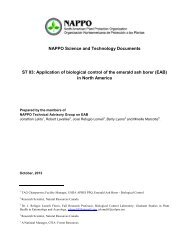NAPPO Regional Standards for Phytosanitary Measures (RSPM)
NAPPO Regional Standards for Phytosanitary Measures (RSPM)
NAPPO Regional Standards for Phytosanitary Measures (RSPM)
You also want an ePaper? Increase the reach of your titles
YUMPU automatically turns print PDFs into web optimized ePapers that Google loves.
Distinction between a Pest Free Area and an Area of Low Pest PrevalenceThe main difference between an ALPP and a PFA is that the presence of the pest below aspecified population level is accepted in an ALPP, whereas the pest must be totally absent fromthe PFA. The choice of an ALPP or PFA as a risk management option will depend on thecharacteristics of the pests, distribution of the pests in the exporting country, and overallfeasibility of the program. Both options can offer adequate protection. The main security of thePFA lies in the application of common phytosanitary measures to an area covering many placesof production. The main security of the ALPP is that specific phytosanitary measures are appliedmore intensively. Possible impacts of an ALPP in comparison to PFA may include increases inhost sampling, the number of traps relative to regular detection level, and control measures.Benefits of Areas of Low Pest Prevalence• Remove need <strong>for</strong> post-harvest treatment when infestation levels remain below the threshold.• Use of non-toxic control measures in the field, e.g., sterile insect technique.• Facilitate market access <strong>for</strong> areas that were previously excluded.• Less restrictive movement controls.• Movement of commodities from one ALPP to another ALPP.• Movement of commodities from an ALPP to a PFA.• Movement of commodities from an ALPP through a PFA.• Movement of commodities from an ALPP through an ALPP.General RequirementsPrior to designating an area of low pest prevalence, the NPPO should ensure that the area meetsthe requirements of this standard and the relevant International <strong>Standards</strong> <strong>for</strong> <strong>Phytosanitary</strong><strong>Measures</strong>. Where this standard addresses issues related to establishment of threshold levels,attention should be paid to the ISPM (currently under development) on pest risk analysis <strong>for</strong>regulated non-quarantine pests.Specific Requirements1. Establishment of an Area of Low Pest PrevalenceLow pest prevalence can occur naturally or be achieved through the application ofphytosanitary procedures aimed at control of the target pest(s). These procedures shouldinclude suppression and containment. Requirements such as field, packinghouse andconveyance controls will vary depending on the commodity, target pest(s), and intendedmarket.The key elements to consider in determining the feasibility of establishing an area of lowpest prevalence include:• The biology of the target pest(s).• Available technology and technical expertise required to establish and maintain an ALPP.• Geographic, operational, and economic factors.• Legislation and regulations required <strong>for</strong> the NPPO to carry on all activities necessary toestablish and maintain the ALPP.<strong>RSPM</strong> No. 20Guidelines <strong>for</strong> the Establishment, Maintenance and Verification of an Area of Low Pest Prevalence <strong>for</strong> Insects Page 8
















